Research - (2021) Oral and Systemic Health
Usage of Gadgets and Bruxism in Children-A Questionnaire Study
Meenapriya M1, Deepa Gurunathan1*, Nivedhitha MS2, Joyson Moses1 and Mahesh Ramakrishnan1
*Correspondence: Deepa Gurunathan, Department of Pediatric and Preventive Dentistry, Saveetha Institution of Medical and Technical Sciences, India, Email:
Abstract
Background: Technology plays a vital role in our daily lives. These include electronic games, home computers, handheld devices and different types of gadgets. Generally, children and adolescents nowadays use gadgets excessively. Usage of gadgets can have negative and positive impacts on children. Bruxism is a non -functional grinding or clenching of teeth. This habit can be conscious or unconscious during the day or night. Aim: This survey aims at assessing the usage of gadgets among children associated with bruxism in children. Materials and Methods: A survey questionnaire on the usage of gadgets and bruxism was prepared. This survey was conducted by circulating among the parents. The questions were focused on the bruxism and usage of gadgets by the children. Bruxism questions were framed according to the guidelines given by American Association of Sleep Medicine. The results were analyzed. Results: There was higher participation of age groups of 6 to 10 years than the other age groups. Most of the children use the gadgets more frequently. Most of the children spend their time playing games online. The awareness of the parents about the ill effects of using gadgets prevails in 60.29% of the parents. Most of the parents attempted to control the usage of gadgets (39.71%). The clenching or grinding of the teeth is present in 67.65%. Most of the children clench their teeth during the day (32.81%). The present study reported that most of the children don’t experience headaches (44.12%) during waking up. 50% don’t experience jaw pain. 51.47% don’t experience tooth or gum pain when waking up. It has also been reported that during stress or after continuous usage of gadgets, 47.06% don’t clench their teeth. 35.29% of the parents are aware that the usage of gadgets can cause tooth grinding. 41.18% of the parents feel that their children’s sleep gets disturbed due to the continuous usage of gadgets. 57.35% of the parents are aware of the treatment strategies. Conclusion: Usage of gadgets does not bring about a direct impact to the child. It does impact the stress, outcome of the score of the games played and so on. Therefore, future studies should be conducted to bring about the correlation of using gadgets and bruxism in children.
Keywords
Bruxism, Gadgets, Children, Temporomandibular disorders, Sleep
Introduction
Bruxism has become an increased concern in recent years. It has an impact on the quality of the person lives mostly in children. Bruxism is an important risk factor for temporomandibular disorders. It causes occlusal wear of teeth and progressively can lead to dental trauma in severe cases. According to previous studies, bruxism is considered as a more important concern in children. The causative factors of bruxism are functional, structural and the psychological factors. It comes under the parafunctional activities of the children leading to damage of the stomatognathic system. It results in the bad quality of sleep [1].
Sleep bruxism, one of the most common forms of bruxism is considered as a movement disorder related to sleep. This parafunctional habit of bruxism is characterized by grinding or clenching of teeth and non- functional teeth contact. Many treatment modalities have been suggested in the previous studies, but the consensus about the most efficient treatment modality is not given [2]. The pathophysiology of these bruxism disorders are unknown. Due to multifactorial influence of the central nervous system, genetic and psychosocial factors, the sleep- wake cycle is disturbed and the motor activities are impaired [3].
The bruxism disorder can occur during both the day and night and it can occur consciously or unconsciously. According to the previous studies, it has been reported that the prevalence of bruxism has a non-specific range. This is due to the difficulty in diagnosis of bruxism and its different treatment methodologies. The side - effects of bruxism are considered as headache, hypermobility, recession and inflammation of the gingiva, pain and hypertrophy of masseter muscles, degenerative changes of temporomandibular joint [4].
According to the studies conducted by previous researches, it has been found that the alert parents enquire about the bruxism habit in their children when the signs and symptoms occur. This will help the clinician in addressing the etiological factors related to the bruxism habit [5]. One of the etiological factors for bruxism is the usage of gadgets and technology among children. According to the previous studies, it was reported that most of the children spend average time on their gadgets. Kids use these gadgets for entertainment, playing games, watching videos, listening to music and so on. They spend their time on their gadgets mostly and they don't care about the sitting posture, brightness of the screen and their vision and health [6].
The usage of these gadgets leads to various adverse effects such as increase in power of eyes due to the brightness, eye irritations, and difficulty in focusing and so on. Previous studies reported that the adverse effects of using gadgets are greater in children than the adults. In a study conducted in 2013, it was reported that 29% of the toddlers can learn the gadgets very easily and 70% of the toddlers become masters of it by primary school [7]. Information Technology plays a major role in the current generation globally. The social and emotional function of the children is disturbed. The use of it has both the negative and the positive impacts on the children. The effects of it depends upon the frequency, duration of usage of gadgets and supervision by the parents. Earlier studies revealed that most of the parents allow their children to use their gadgets freely without any supervision and control over it [8]. This may have a great impact on the children's mental health. Parents should be aware of their children’s usage of gadgets and they should be given awareness about the adverse effects of these technologies.
Our department is passionate about child care, we have published numerous high quality articles in this domain over the past 3 years [9- 27]. With this inspiration we planned to pursue research on assessing the usage of gadgets in children associated with bruxism.
Materials and Methods
This study is a questionnaire study conducted among the parents. This study was conducted in 2020. The study had the advantages of easier data collection due to the online questionnaire circulated. The survey was conducted only among the specific population and the prevalence of usage of gadgets and their association with bruxism were noted.
The survey was conducted among the parents to assess their children’s usage of gadgets and any parafunctional habits, like bruxism. Online questionnaire was prepared and circulated. Measures taken to minimize the sampling bias were done. The questionnaire was framed in a simple manner and easily understandable by everyone. Hence, accurate results were provided. The validity to this questionnaire was provided by approval from the authors. Since a randomized sampling was done among the general public, the study results can be generalized to the South Indian population.
For the data collection, this questionnaire was circulated through google forms. The data were collected and distribution was done according to various responses by the parents. The validity and reliability of this study was assessed. The incomplete data which included the inappropriate responses were managed by exclusion of the same.
This online questionnaire study was analyzed. The data was tabulated in SPSS. The descriptive analysis of this survey was done and the graphs were prepared based upon the responses.
Results
The age distribution of the children whose parents participated in the survey were 1 to 5 years (33.90%), 6 to 10 years (35.59%), 11 to 15 years (23.73%), 16 to 20 years (6.78%). There was higher participation of age groups of 6 to 10 years than the other age groups (Figure 1). This study showed the higher participation of male participants (78.47%) than the females (23.53%) (Figure 2). The duration of usage of gadgets among the children were noted according to the recommendations given in the previous studies. The duration of usage of gadgets were often (40.30%), medium usage (34.33%), rare (16.42%) and never (8.96%). Therefore, most of the children use the gadgets more frequently (Figure 3). The activities in which the children spend their time were playing games (37.50%), entertainment videos (14.29%), educational activities (10.71%), picture gallery and chatting (8.93%), all the above activities (19.64%) and none (8.93%). Therefore, most of the children spend their time playing games online (Figure 4). The awareness of the parents about the ill effects of using gadgets prevails in 60.29% of the parents and 17.65% were unaware and 22.06% were aware to some extent (Figure 5). The attempts made by the parents in controlling the usage of gadgets were done always by 39.71%, never by 8.82% of the parents and 51.47% sometimes control their children on the usage of gadgets (Figure 6).
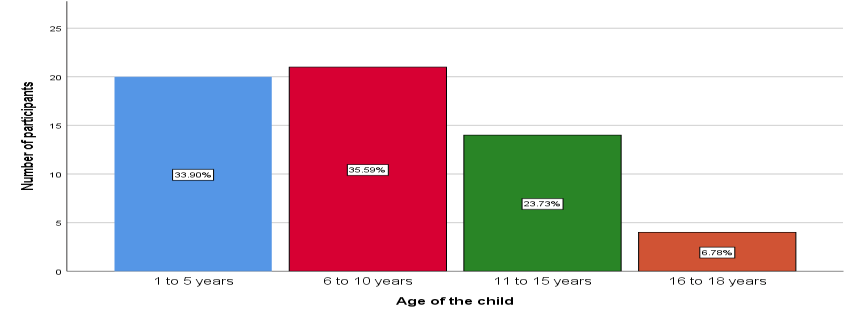
Figure 1:Bar graph showing the distribution of age groups of the child. Age groups involved are 1 to 5 years (Blue), 6 to 10 years (Red), 11 to 15 years (Green), 16 to 18 years (Orange). X axis represents the age of the child involved in this study and Y axis represents the number of participants. This graph shows the higher participation of age groups of 6 to 10 years (35.59%) whose parents were involved in this study.
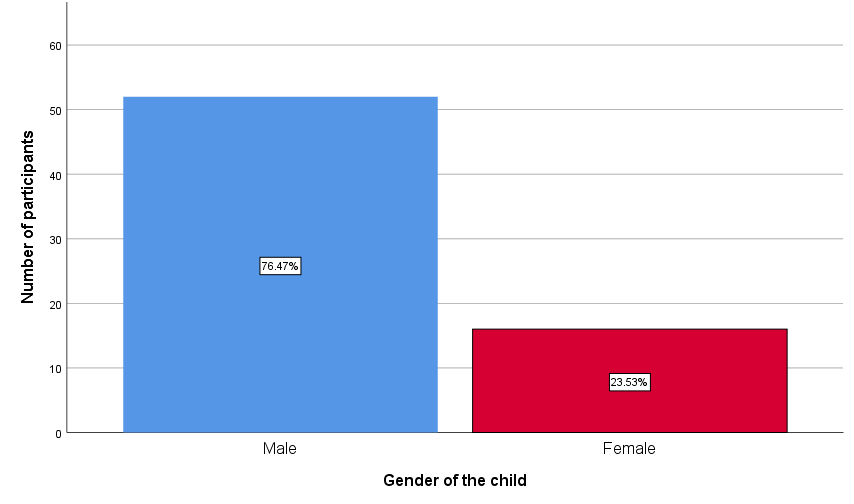
Figure 2:Bar graph showing the gender of the child. Male (Blue), Female (Red). X axis represents the gender of the child involved in this study and Y axis represents the number of participants. This graph shows the higher participation of male participants (78.47%) than the females (23.53%).
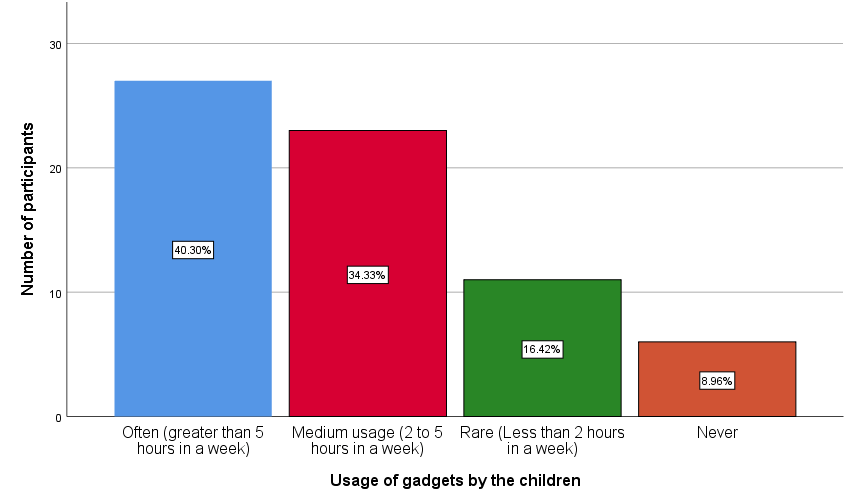
Figure 3:Bar graph showing the duration of usage of gadgets by the children. The duration of usage was often (Blue), medium usage (Red),rare (Green) and never (Orange). X axis represents the duration of gadgets by the children and Y axis represents the number of participants involved. This graph shows the more often usage of gadgets, greater than 5 hours in a week (40.30%) by the children.
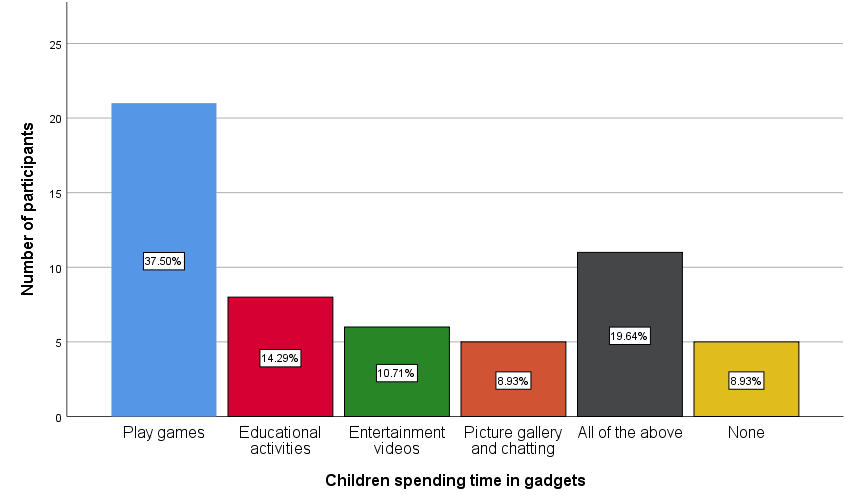
Figure 4:Bar graph showing the children spending time in gadgets for various activities. The activities are the play games (Blue), educational activities (Red), entertainment videos (Green), picture gallery and chatting (Orange), all the mentioned activities (Black), none (Yellow). X axis represents the children spending time for activities on their gadgets and Y axis represents the number of participants. This graph shows that a higher number of children spend time on playing games in their gadgets (37.50%) than the other activities.
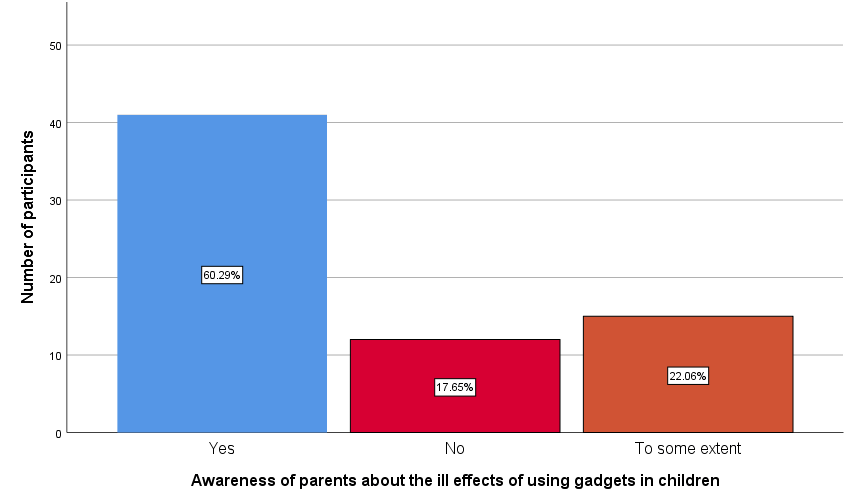
Figure 5:Bar graph showing the awareness of parents about the ill effects of using gadgets in children. Aware (Blue), Not aware (Red), To some extent (Orange). X axis represents the awareness of parents about ill effects of using gadgets and Y axis represents the number of participants involved. This graph shows that most of the parents are aware about the ill effects of using gadgets in children (60.29%).
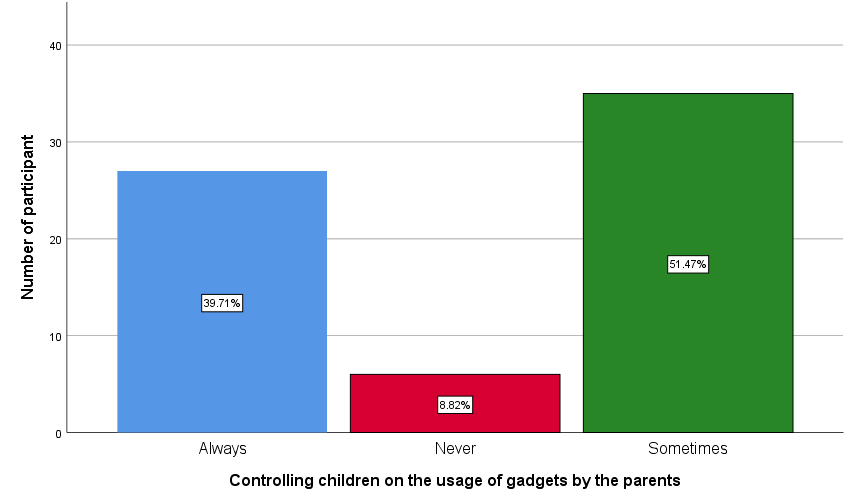
Figure 6:Bar graph showing the attempts to stop the usage of gadgets among children by their parents. Always (Blue), Never (Red), Sometimes (Green). X axis represents the attempts made by parents to stop the usage of gadgets in children and Y axis represents the number of participants. This graph shows that most of the parents have made an attempt sometimes to stop the usage of gadgets among their children (51.47%).
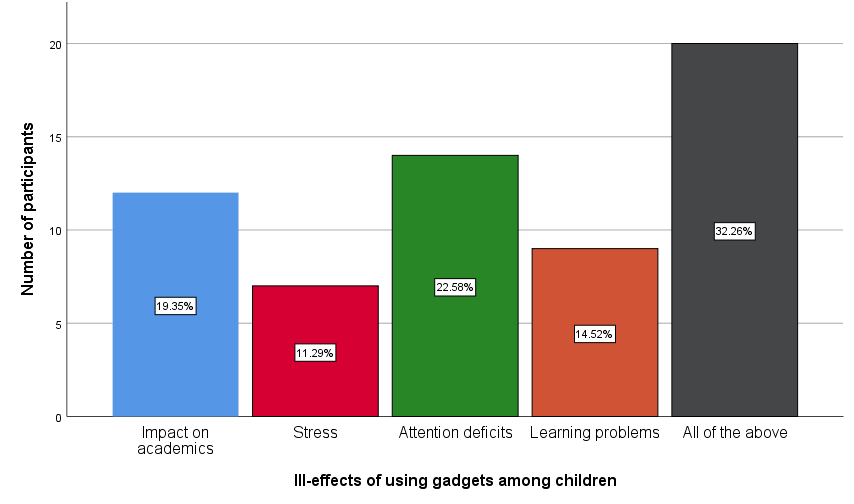
Figure 7:Bar graph showing the ill-effects of using gadgets among children. Impact on academics (Blue), Stress (Red), Attention deficits (Green), Learning problems (Orange), All of the above (Brown). X axis represents the ill-effects considered by the parents and Y axis represents the number of participants. This graph shows that most of the parents have chosen all the reasons as the ill-effect of using gadgets in their children (32.26%).
The ill-effects of using gadgets according to the parents were impact of academics (19.35%), stress (11.29%), attention deficits (22.58%), learning problems (14.52%), all the above effects (32.36%) (Figure 7). The positive impacts of using gadgets according to the parents were improved cognitive skills (37.10%), better motor skills (17.74%), more fun for kids (19.35%) and none (25.81%) (Figure 8). The clenching or grinding of the teeth is present in 67.65% and 32.35% of the children do not have clenching teeth (Figure 9). The situations in which the children use these gadgets were during the day by 32.81% of children, during night (18.75%), during both day and night (23.44%), during emotional disturbances like stress by 14.06% of children and after prolonged usage of gadgets by 10.94% of the children (Figure 10). This study reported that 42.65% of the children clench their teeth during night and 57.35% don’t clench their teeth during night (Figure 11).
The present study reported that 32.35% of the children experience temporal headaches on waking up in the morning. 44.12% don’t experience headaches and 23.53% experience headaches sometimes during waking up (Figure 12). 25% of the children experience jaw fatigue on waking up, 50% don’t experience jaw pain and 25 % experience it sometimes (Figure 13). It has been reported that 30.88% of children experience tooth pain or gum pain on waking up, 51.47% don’t experience it and 17.65% of children experience it sometimes (Figure 14). It has also been reported that during stress or after continuous usage of gadgets, 25% of children clench their teeth. 47.06% don’t clench their teeth and 27.94% of children clench their teeth sometimes (Figure 15). 35.29% of the children are aware that the usage of gadgets can cause tooth grinding and 36.76% of children are unaware and 27.94% of the children are aware to some extent (Figure 16).
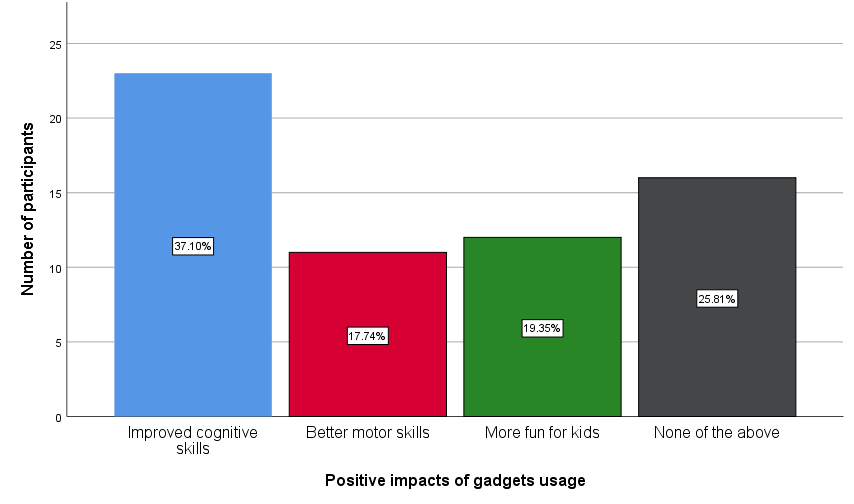
Figure 8:Bar graph showing the positive impacts of using gadgets. Improved cognitive skills (Blue), Better motor skills (Red), More fun for kids (Green), None of the above (Black). X axis represents the positive impacts of using gadgets and Y axis represents the number of participants involved. This graph shows that most of the parents prefer that there will be improved cognitive skills among the children upon the usage of gadgets (37.10%).
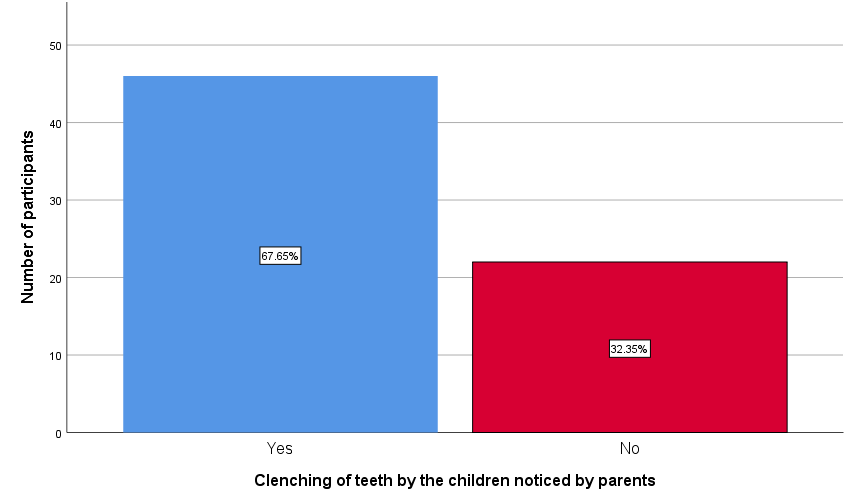
Figure 9:Bar graph showing the children who clenches their teeth which are noted by the parents. Children who clench their teeth (Blue), who don't clench their teeth (Red). X axis represents the clenching of teeth by the children and Y axis represents the number of participants involved. This graph shows that a higher number of children clench their teeth (67.65%).
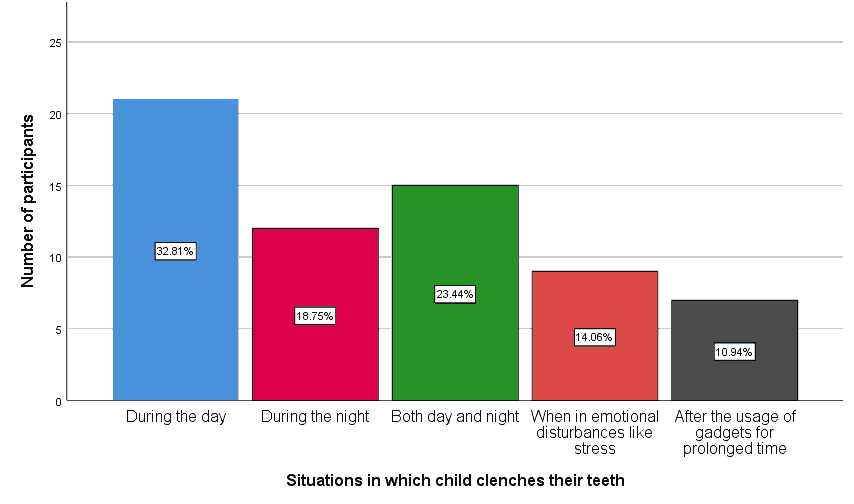
Figure 10:Bar graph showing the various situations in which the children clench their teeth. During the day (Blue), During the night (Red), Both day and night (Green), During emotional disturbances like stress (Orange), After the usage of gadgets for a long time (Black). X axis represents the situations in which the child clenches their teeth and Y axis represents the number of participants involved. This graph shows that a higher number of children clench their teeth during the day (32.81%).
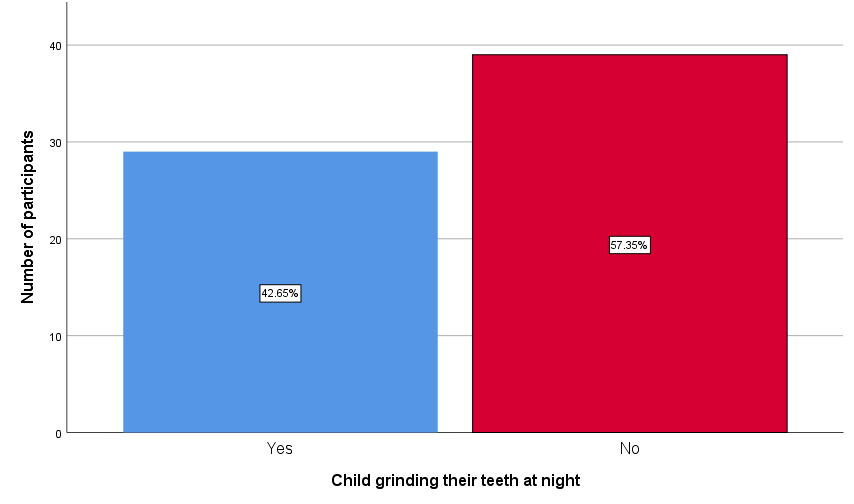
Figure 11:Bar graph showing the children grinding their teeth at night. Children who grind their teeth (Blue), children who don't (Red). X-axis represents the children grinding their teeth at night and Y-axis represents the number of participants. This graph shows that most of the children don’t grind their teeth during night (57.35%).
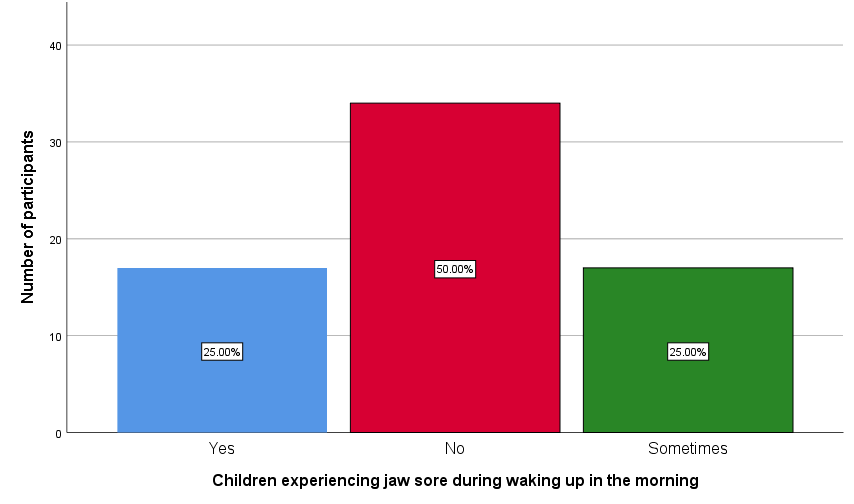
Figure 12:Bar graph showing the responses of the child experiencing temporal headaches on waking up during morning. Children having headaches (blue), not having headaches (Red), sometimes (Green). X axis represents the children experiencing temporal headaches on waking up in the morning and Y axis represents the number of participants involved. This graph shows that most of the children do not experience temporal headaches when they wake up in the morning (44.12%).
41.18% of the parents feel that their children’s sleep gets disturbed due to the continuous usage of gadgets and 30.88% of the parents are against this and 27.94% are not sure (Figure 17). 57.35% of the parents are aware of the treatment strategies and 42.65% of the parents are unaware about the treatment strategies (Figure 18).
Discussion
Technologies play a significant role among toddlers and adolescents. The communication technology, a way of exchanging information between the speaker and the listener. According to the earlier studies, this technology is inappropriate for use among the younger generations. Through the usage of gadgets, everything enters into the mind of the children as a visual stimulation. Hence, the cognitive skills of the children are reduced. These cognitive skills are obtained through playing outdoor games, drawing books and so on [28].
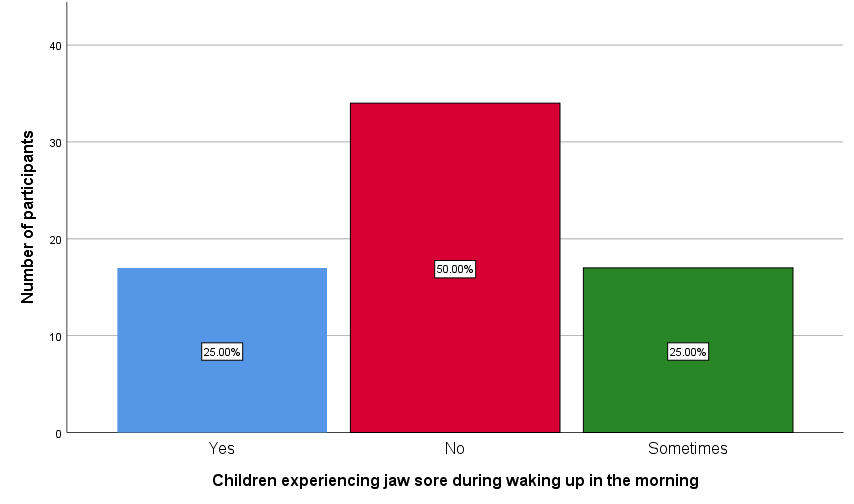
Figure 13:Bar graph showing the responses of the child experiencing jaw sore during waking up in the morning. Children experiencing jaw fatigue (Blue), children not experiencing jaw pain (Red), sometimes (Green). X axis represents the children experiencing jaw sore during waking up in the morning and Y axis represents the number of participants involved. This graph shows that most of the children do not experience jaw fatigue on waking up in the morning (50.00%).
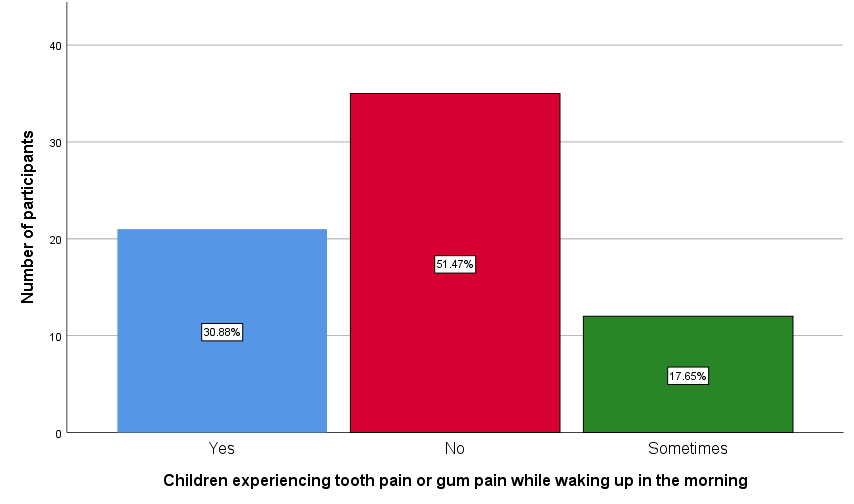
Figure 14:Bar graph showing the responses of the children on whether they experience tooth pain or gum pain while they wake up in the morning. Children having tooth pain (Blue), children not having tooth or gum pain (Red), sometimes (Green). X axis represents the children who are experiencing the tooth or gum pain while they wake up in the morning and Y axis represents the number of participants involved. This graph shows that most of the children do not experience tooth or gum pain when they wake up in the morning (51.47%).
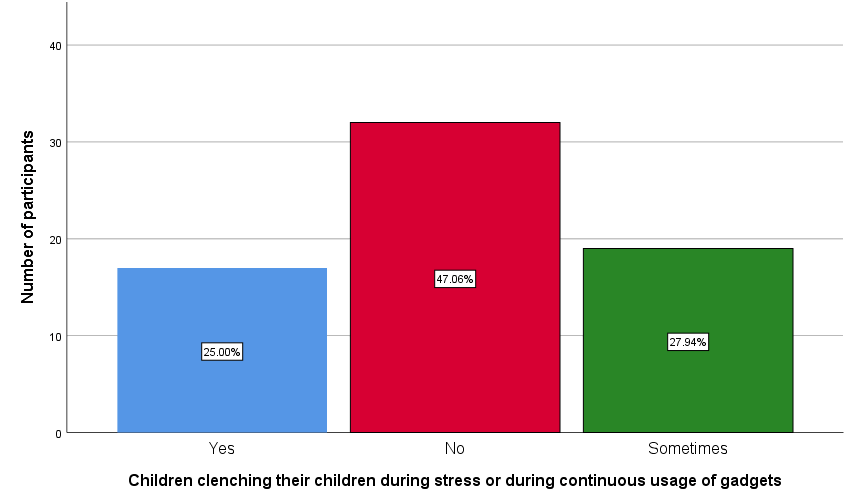
Figure 15:Bar graph showing the response on whether the child clenches their teeth during stress or after continuous usage of gadgets. Children clenching during stress (Blue), children not clenching after stress due to gadgets (Red), sometimes during stress (Green). X axis represents the children who clench their teeth during stress or during continuous usage of gadgets. This graph represents that most of the children do not clench their teeth during stress or after continuous usage of gadgets (47.06%).
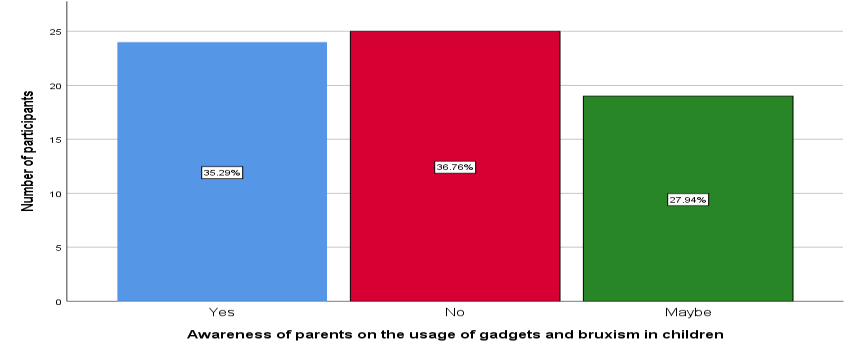
Figure 16:Bar graph showing the awareness of parents on the usage of gadgets and bruxism in children. Children who were aware (Blue), children who are not aware (Red), maybe (Green). X axis represents the awareness of parents on the usage of gadgets and bruxism in children and Y axis represents the number of participants involved. This graph shows that most of the parents were not aware of the association of gadgets and bruxism in children (36.76%).
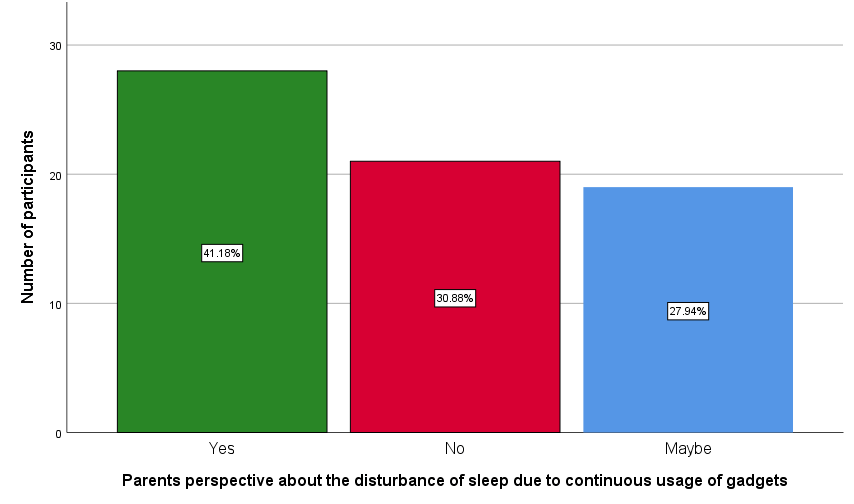
Figure 17:Bar graph showing the parents intuition about the disturbance of sleep due to the continuous usage of gadgets. Sleep gets disturbed due to gadgets (Green), does not get disturbed (Red), maybe disturbed due to gadgets (Blue). X axis represents the parents feeling about the disturbed sleep of their children due to continuous usage of gadgets and Y axis represents the number of participants involved. This graph shows that most of the parents feel that their children have disturbed sleep due to the continuous usage of gadgets (41.18%).
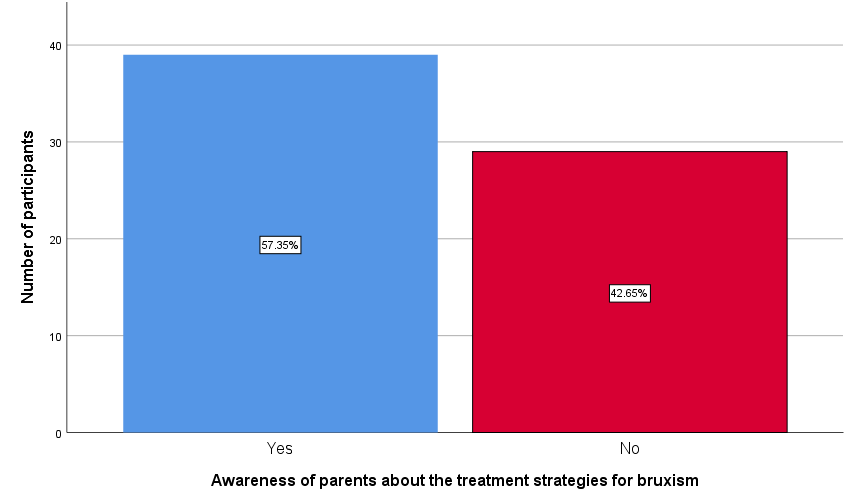
Figure 18:Bar graph showing the awareness of parents about the treatment strategies for bruxism. Aware (Blue), not aware (Red). X axis represents the awareness of parents on the treatment strategies for bruxism and Y axis represents the number of participants involved. This graph shows that 57.35% of the parents are aware about the treatment strategies of bruxism.
Spending time in gadgets reduces the duration of interaction between children and the parents. The quantity of time and quality of life spent with the children is getting reduced. Earlier studies have shown that children, who interact less time with their parents, are more likely to have speech related problems [29]. However, this can also be related to the genetic and environmental related factors. It has been reported that the recommended sleeping duration for children is from 9 to 13 hrs. However, most of the children do not sleep for these hours which impacts upon the side-effects associated with the sleeping disorders. In a study conducted by Johnson et al., it has been reported that 11.6% of the children who have sleeping problems have bruxism disorder [30].
Bruxism or teeth clenching has been reported to occur along with neurological disorders, medications, electrical stimulations and so on. The acute form of bruxism occurs upon waking up during the morning. This leads to the development of secondary risk factors. This is considered as the hallmark of underlying bruxism [31]. The management of bruxism disorders focuses primarily on the occlusal wear facets and treatment of etiological factors. Conservative measures such as the occlusal splints should be given.
The research conducted by a national survey in the US has reported that the average time of using gadgets among children is 6h and 21 min daily. [32]. It reported that the media has a profound impact on the psychological and social development of the children. The increased levels of non-homework screen times leads to the addictive behaviour of children. This was termed as the screen dependency disorders. Studies have shown that these screen dependency disorders during stages of the neurological development can alter the genetic expressions which results in the functional changes of the developing brain [33]. A study conducted by South Korea among young adolescents identified that 13.8% of the children are under Internet Gaming disorder risk groups. These risk groups are the mental disorders which are named by American Psychiatric Association. Several recommendations have been recommended by various organisations [34].
Children playing online games feel stressed about winning and depressed about losing it. The usage of gadgets leading to stress, anxiety, mental illness can affect the patients through dental as well as non-dental origin. According to the previous study, Schizophrenia is a rare disorder which will lead to lack of interest and concentration at school and this is the first noted disorder in children who are under higher usage of gadgets [35]. The masticatory muscles are the temporalis, medial pterygoid, lateral pterygoid and masseter. The activity of these muscles can be functional as well as the para-functional. It includes clenching or grinding of teeth, bracing and gnashing of it. Studies have also been reported on the prevalence of diurnal bruxism which occurs during the day time. The nocturnal bruxism is related to sleep and has characteristic clenching and grinding type of activity [36].
Stress is encountered in an individual life due to a variety of reasons. The International Labour Office has reported that the stress and mental illness have become an increasing problem in information technology workplaces [37]. The individuals working in these places are more prone to stress in the initial stages of working with the computer. This action of working in a computer for a prolonged period leads to the lack of cognitive skills among the individuals. It has been reported that the motor skills become deficient. The etiology of stress due to gadgets and bruxism is considered as a cause-effect relationship. The provision of dental care for children with bruxism has become a challenging factor.
According to a study conducted previously, it has been found that there is increased anxiety levels and somatization symptoms in patients with bruxism when they approach for the primary treatments [38]. The various treatment strategies are the relaxation techniques, changing sleep patterns, splint therapy, pharmacological therapy and electrical stimulations. It has been reported that during the initial treatment, the sleep patterns should be observed by the parents for 4 weeks. Occlusal splints are indicated in patients during sleep. These will help in preventing the occlusal wear of facets in the teeth. The patient bites on to the tooth rather than biting on tooth which can cause tooth sore and jaw pain during waking up in the morning.
Various drugs have been found effective against the effects of bruxism. Among those are the amitriptyline, levodopa, bromocriptine, and propranolol. These are considered to be the first line of treatment drugs according to the previous studies conducted. Recent studies have also been conducted on the botulinum injections for the treatment of bruxism [39]. Thus early diagnosis will prevent the further adverse effects of bruxism.
Conclusion
Within the limits of this study, it was found that the prevalence of usage of gadgets is higher among the children. It is more prevalent among the age groups of 6 to 10 years and they use it more often. This study reported that most of the children engage their time in playing games followed by the other activities like entertainment, educational activities, etc. The awareness about the ill-effects of usage of the gadgets prevails to some extent among the parents and only few parents show limitations in the usage of gadgets by the children. This study reported that the children who clench their teeth have disturbed sleep and the clenching of teeth is more common in children who have stress after continuous usage of gadgets. Usage of gadgets does not bring about a direct impact to the child. It does impact the stress, outcome of the score of the games played and so on. Therefore, more studies should be conducted to bring about the association of using gadgets and bruxism in children.
References
- Simões-Zenari M, Bitar ML. Factors associated to bruxism in children from 4-6 years. Revista Atualizacao Cientifica 2010; 22:465â??472.
- Machado E, Dal-Fabbro C, Cunali PA, et al. Prevalence of sleep bruxism in children: A systematic review. Dent Press J Orthodont 2014; 19:54-61.
- Seraj B, Shahrabi M, Ghadimi S, et al. The prevalence of bruxism and correlated factors in children referred to dental schools of Tehran, based on parent's report. Iranian J Pediatr 2010; 20:174.
- Sundus M. The impact of using gadgets on children. J Depression Anxiety 2018; 7:1â??3.
- Wahyuni AS, Siahaan FB, Mudia Arfa IA, et al. The relationship between the duration of playing gadget and mental emotional state of elementary school students. Open access Macedonian J Med Sci 2019; 7:148.
- Suhana M. Influence of gadget usage on children's social- emotional development. In International Conference of Early Childhood Education (ICECE 2017). Atlantis Press 2017.
- Nugraha A, Izah N, Hidayah SN, et al. The effect of gadget on speech development of toddlersâ??, Journal of physics. Conference Series 2019; 1175:012203.
- Tharakan RM, Varadraj Shenoy K. A study on sleep patterns and sleep problems in children aged 6 to 15 years as perceived by their parents. Int J Contemporary Pediatr 2019; 611.
- Govindaraju L, Jeevanandan G, Subramanian EMG. Comparison of quality of obturation and instrumentation time using hand files and two rotary file systems in primary molars: A single-blinded randomized controlled trial. Eur J Dent 2017; 11:376â??379.
- Govindaraju L, Jeevanandan G, Subramanian EMG. Knowledge and practice of rotary instrumentation in primary teeth among Indian dentists: A questionnaire survey. J Int Oral Health 2017; 9:45.
- Panchal V, Gurunathan D, Shanmugaavel AK. Smartphone application as an aid in determination of caries risk and prevention: A pilot study. Eur J Dent 2017; 11:469â??474.
- Ravikumar D, Jeevanandan G, Subramanian EMG. Evaluation of knowledge among general dentists in treatment of traumatic injuries in primary teeth: A cross-sectional questionnaire study. Eur J Dent 2017; 11:232â??237.
- Jeevanandan G, Govindaraju L. Clinical comparison of Kedo-S paediatric rotary files vs manual instrumentation for root canal preparation in primary molars: A double blinded randomised clinical trial. Eur Archives Paediatr Dent 2018; 19:273â??278.
- Nair M, Jeevanandan G, Vignesh R, et al. Comparative evaluation of post-operative pain after pulpectomy with k-files, kedo-s files and mtwo files in deciduous molars-a randomized clinical trial. Br Dent Sci 2018; 21:411-417.
- Ravikumar D, Gurunathan D, Gayathri R, et al. DNA profiling of Streptococcus mutans in children with and without black tooth stains: A polymerase chain reaction analysis. Dent Res J 2018; 15:334.
- Dhanalakshmi Ravikumar SN, Ramakrishna M, Sharna N, et al. Evaluation of McNamaraâ??s analysis in South Indian (Tamil Nadu) children between 8â??12 years of age using lateral cephalograms. J Oral Biol Craniofac Res 2019; 9:193.
- Ravindra V, Rekha V, Annamalai S, et al. A comparative evaluation between dermatoglyphic patterns and different terminal planes in primary dentition. J Clin Exp Dent 2018; 10:e1149.
- Ravindra V, Rekha CV, Annamalai S, et al. A comparative evaluation between cheiloscopic patterns and the permanent molar relationships to predict the future malocclusions. J Clin Exp Dent 2019; 11:e553.
- Subramanyam D, Gurunathan D, Gaayathri R, et al. Comparative evaluation of salivary malondialdehyde levels as a marker of lipid peroxidation in early childhood caries. Eur J Dent 2018; 12:67.
- Vishnu Prasad S, Kumar M, Ramakrishnan M, et al. Report on oral health status and treatment needs of 5â??15 years old children with sensory deficits in Chennai, India. Special Care Dent 2018; 38:58-59.
- Jeevanandan G, Ganesh S, Arthilakshmi. Kedo file system for root canal preparation in primary teeth. Indian J Dent Res 2019; 30:622â??624.
- Ramadurai N, Gurunathan D, Samuel AV, et al. Effectiveness of 2% Articaine as an anesthetic agent in children: randomized controlled trial. Clin Oral Investigations 2019; 23:3543-3550.
- Ramakrishnan M, Dhanalakshmi R, Subramanian EMG. Survival rate of different fixed posterior space maintainers used in paediatric dentistry-A systematic review. Saudi Dent J 2019; 31:165â??172.
- Panchal V, Jeevanandan G, Subramanian E. Comparison of instrumentation time and obturation quality between hand K-file, H-files, and rotary Kedo-S in root canal treatment of primary teeth: A randomized controlled trial. J Indian Society Pedodont Preventive Dent 2019; 37:75â??79.
- Vignesh R, Ditto Sharmin C, Annamalai S, et al. Management of complicated crown-root fracture by extra-oral fragment reattachment and intentional reimplantation with 2 years review. Contemporary Clin Dent 2019; 10:397.
- Panchal V, Jeevanandan G, Subramanian EMG. Comparison of post-operative pain after root canal instrumentation with hand K-files, H-files and rotary Kedo-S files in primary teeth: a randomised clinical trial. Eur Archives Paediatr Dent 2019; 20:467â??472.
- Samuel SR, Acharya S, Rao JC. School interventions- based prevention of early-childhood caries among 3-5-year-old children from very low socioeconomic status: Two-year randomized trial. J Public Health Dent 2020; 80:51â??60.
- Guaita M, Högl B. Current treatments of bruxism. Current Treatment Options Neurol 2016; 18:10.
- Naik S. Children and their gadgets: A pedodontist perspective. Int J Oral Health Sci 2018; 8:57.
- Johnson KW. Parental perceptions of the influence of digital media and technology on childrenâ??s reading habits at home. Utah State University 2014.
- Nirmala S. Dental care and treatment of children with emotional disorders--An overview. Autism Open Access 2016; 6:2.
- Rao SK, Bhat M, David J. Work, stress, and diurnal bruxism: a pilot study among information technology professionals in Bangalore city, India. Int J Dent 2011; 2011:650489.
- Zafar S, Boyd D, Siddiqi A. Dental management of a child with autism spectrum disorder and attention-deficit hyperactivity disorder. Oral Health Dent Management 2017; 16:1â??7.
- Roberts DF. Generation M: Media in the lives of 8-18 year-olds. Henry J Kaiser Family Foundation 2005.
- Kuss DJ, Lopez-Fernandez O. Internet addiction and problematic Internet use: A systematic review of clinical research. World J Psych 2016; 6:143â??176.
- Ahlberg J, Rantala M, Savolainen A, et al. Reported bruxism and stress experience. Community Dent Oral Epidemiol 2002; 30:405-408.
- Emelin V, Tkhostov A, Rasskazova E. Excessive use of internet, mobile phones and computers: The role of technology-related changes in needs and psychological boundaries. Social Behavioral Sci 2013; 86:530â??535.
- Bharti B, Malhi P, Kashyap S. Patterns and problems of sleep in school going children. Indian Pediatr 2006; 43:35â??38.
- Fatnani RH, Minajagi SK, Rao C, et al. Study of sleep problems and their association with scholastic performance in school going children. Indian J Child Health 2015; 2:200-203.
Author Info
Meenapriya M1, Deepa Gurunathan1*, Nivedhitha MS2, Joyson Moses1 and Mahesh Ramakrishnan1
1Department of Pediatric and Preventive Dentistry, Saveetha Institution of Medical and Technical Sciences, India2Department of Conservative Dentistry and Endodontics, Saveetha Institution of Medical and Technical Sciences, India
Citation: Meenapriya M, Deepa Gurunathan, Nivedhitha MS, Joyson Moses, Mahesh Ramakrishnan, Usage of Gadgets and Bruxism in Children-A Questionnaire Study, J Res Med Dent Sci, 2021, 9 (S1): 25-35.
Received: 23-Feb-2021 Accepted: 10-Mar-2021 Published: 18-Mar-2021
